Comprehensive Report: Managing Business Performance, Margrin Company
VerifiedAdded on 2023/01/06
|11
|3249
|54
Report
AI Summary
This report provides a comprehensive analysis of managing business performance, focusing on key concepts and their application within a business context. The report begins by explaining the principle of lifecycle costing and evaluating its relevance for Margrin Company, including a discussion on how it differs from traditional cost accounting and its benefits such as effective decision-making and long-term incentives. It then presents a budgeted result for Margrin, analyzing the company's performance over three years and identifying areas for improvement, such as boosting sales to maximize profit margins. The report also examines incremental budgeting, explaining its common usage and identifying its drawbacks, such as the potential for excessive spending and hindering creative ideas. Furthermore, the report delves into environmental management accounting (EMA), detailing its role in the modern business environment and its benefits, such as improving revenue, reducing costs, and enhancing the company's reputation. Finally, the report explores Total Quality Management (TQM), outlining its features and emphasizing its customer-focused approach. Overall, the report offers valuable insights into various aspects of business performance management, providing practical recommendations for Margrin Company and other businesses to enhance their efficiency and profitability.
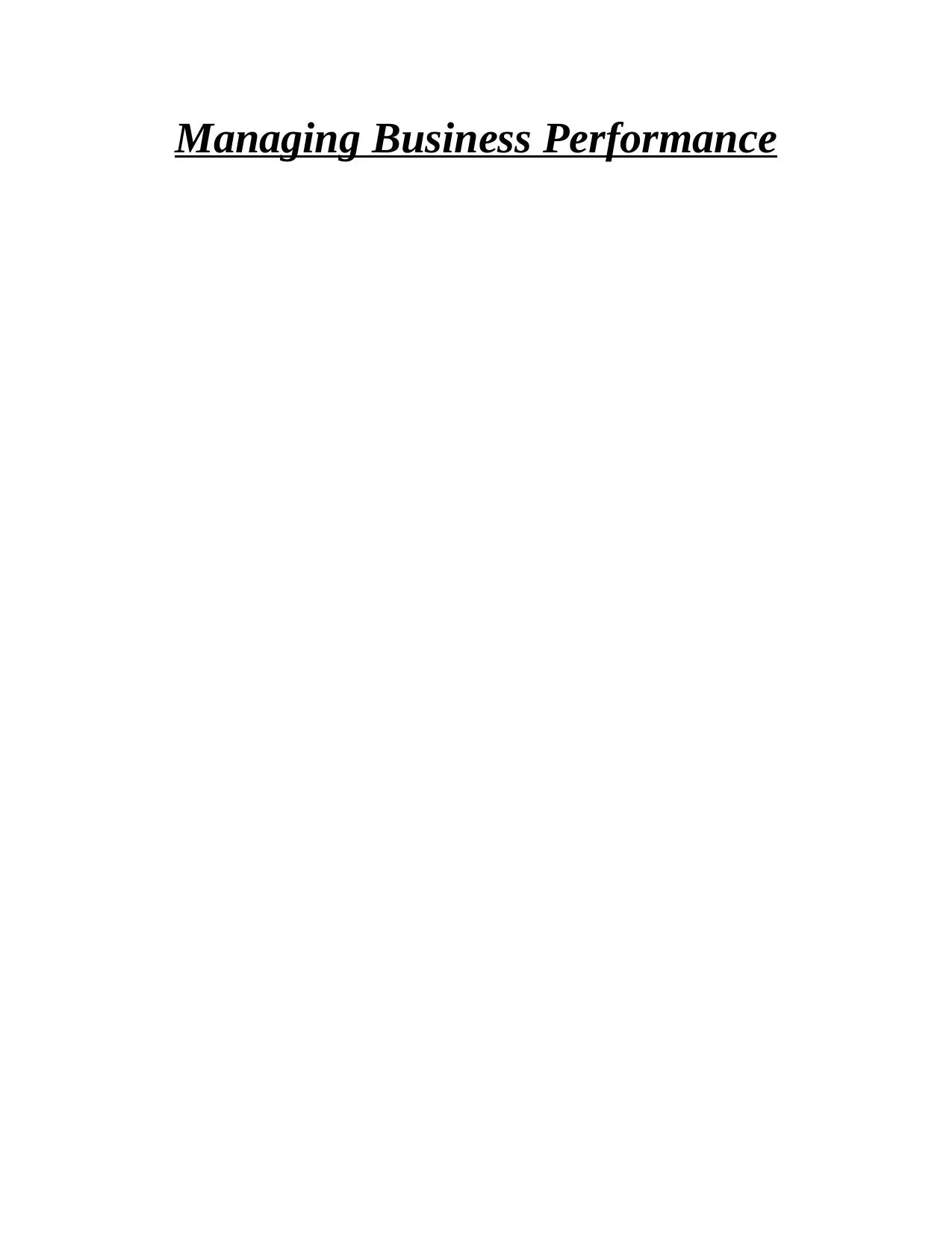
Managing Business Performance
Paraphrase This Document
Need a fresh take? Get an instant paraphrase of this document with our AI Paraphraser
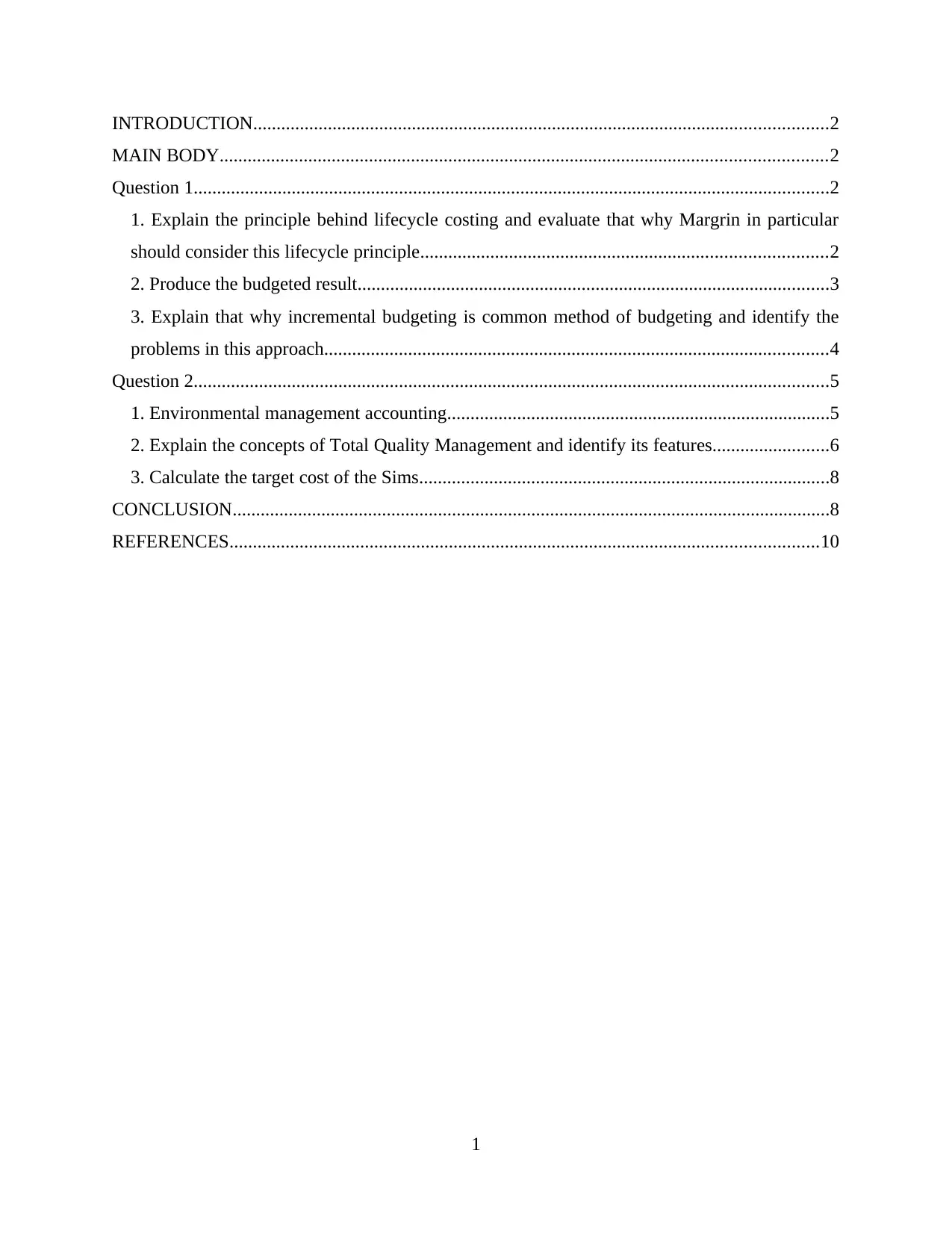
INTRODUCTION...........................................................................................................................2
MAIN BODY..................................................................................................................................2
Question 1........................................................................................................................................2
1. Explain the principle behind lifecycle costing and evaluate that why Margrin in particular
should consider this lifecycle principle.......................................................................................2
2. Produce the budgeted result.....................................................................................................3
3. Explain that why incremental budgeting is common method of budgeting and identify the
problems in this approach............................................................................................................4
Question 2........................................................................................................................................5
1. Environmental management accounting..................................................................................5
2. Explain the concepts of Total Quality Management and identify its features.........................6
3. Calculate the target cost of the Sims........................................................................................8
CONCLUSION................................................................................................................................8
REFERENCES..............................................................................................................................10
1
MAIN BODY..................................................................................................................................2
Question 1........................................................................................................................................2
1. Explain the principle behind lifecycle costing and evaluate that why Margrin in particular
should consider this lifecycle principle.......................................................................................2
2. Produce the budgeted result.....................................................................................................3
3. Explain that why incremental budgeting is common method of budgeting and identify the
problems in this approach............................................................................................................4
Question 2........................................................................................................................................5
1. Environmental management accounting..................................................................................5
2. Explain the concepts of Total Quality Management and identify its features.........................6
3. Calculate the target cost of the Sims........................................................................................8
CONCLUSION................................................................................................................................8
REFERENCES..............................................................................................................................10
1
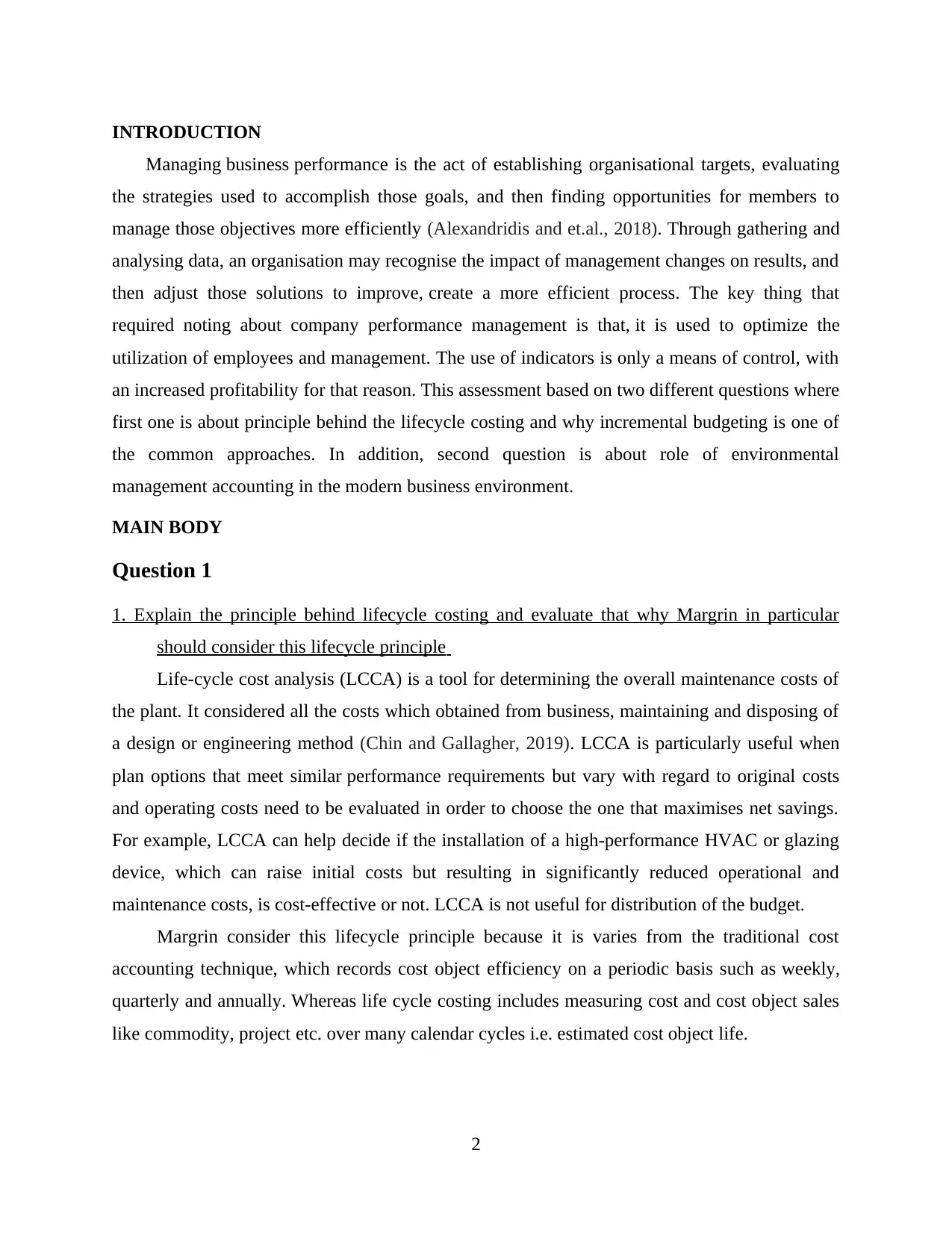
INTRODUCTION
Managing business performance is the act of establishing organisational targets, evaluating
the strategies used to accomplish those goals, and then finding opportunities for members to
manage those objectives more efficiently (Alexandridis and et.al., 2018). Through gathering and
analysing data, an organisation may recognise the impact of management changes on results, and
then adjust those solutions to improve, create a more efficient process. The key thing that
required noting about company performance management is that, it is used to optimize the
utilization of employees and management. The use of indicators is only a means of control, with
an increased profitability for that reason. This assessment based on two different questions where
first one is about principle behind the lifecycle costing and why incremental budgeting is one of
the common approaches. In addition, second question is about role of environmental
management accounting in the modern business environment.
MAIN BODY
Question 1
1. Explain the principle behind lifecycle costing and evaluate that why Margrin in particular
should consider this lifecycle principle
Life-cycle cost analysis (LCCA) is a tool for determining the overall maintenance costs of
the plant. It considered all the costs which obtained from business, maintaining and disposing of
a design or engineering method (Chin and Gallagher, 2019). LCCA is particularly useful when
plan options that meet similar performance requirements but vary with regard to original costs
and operating costs need to be evaluated in order to choose the one that maximises net savings.
For example, LCCA can help decide if the installation of a high-performance HVAC or glazing
device, which can raise initial costs but resulting in significantly reduced operational and
maintenance costs, is cost-effective or not. LCCA is not useful for distribution of the budget.
Margrin consider this lifecycle principle because it is varies from the traditional cost
accounting technique, which records cost object efficiency on a periodic basis such as weekly,
quarterly and annually. Whereas life cycle costing includes measuring cost and cost object sales
like commodity, project etc. over many calendar cycles i.e. estimated cost object life.
2
Managing business performance is the act of establishing organisational targets, evaluating
the strategies used to accomplish those goals, and then finding opportunities for members to
manage those objectives more efficiently (Alexandridis and et.al., 2018). Through gathering and
analysing data, an organisation may recognise the impact of management changes on results, and
then adjust those solutions to improve, create a more efficient process. The key thing that
required noting about company performance management is that, it is used to optimize the
utilization of employees and management. The use of indicators is only a means of control, with
an increased profitability for that reason. This assessment based on two different questions where
first one is about principle behind the lifecycle costing and why incremental budgeting is one of
the common approaches. In addition, second question is about role of environmental
management accounting in the modern business environment.
MAIN BODY
Question 1
1. Explain the principle behind lifecycle costing and evaluate that why Margrin in particular
should consider this lifecycle principle
Life-cycle cost analysis (LCCA) is a tool for determining the overall maintenance costs of
the plant. It considered all the costs which obtained from business, maintaining and disposing of
a design or engineering method (Chin and Gallagher, 2019). LCCA is particularly useful when
plan options that meet similar performance requirements but vary with regard to original costs
and operating costs need to be evaluated in order to choose the one that maximises net savings.
For example, LCCA can help decide if the installation of a high-performance HVAC or glazing
device, which can raise initial costs but resulting in significantly reduced operational and
maintenance costs, is cost-effective or not. LCCA is not useful for distribution of the budget.
Margrin consider this lifecycle principle because it is varies from the traditional cost
accounting technique, which records cost object efficiency on a periodic basis such as weekly,
quarterly and annually. Whereas life cycle costing includes measuring cost and cost object sales
like commodity, project etc. over many calendar cycles i.e. estimated cost object life.
2
⊘ This is a preview!⊘
Do you want full access?
Subscribe today to unlock all pages.

Trusted by 1+ million students worldwide
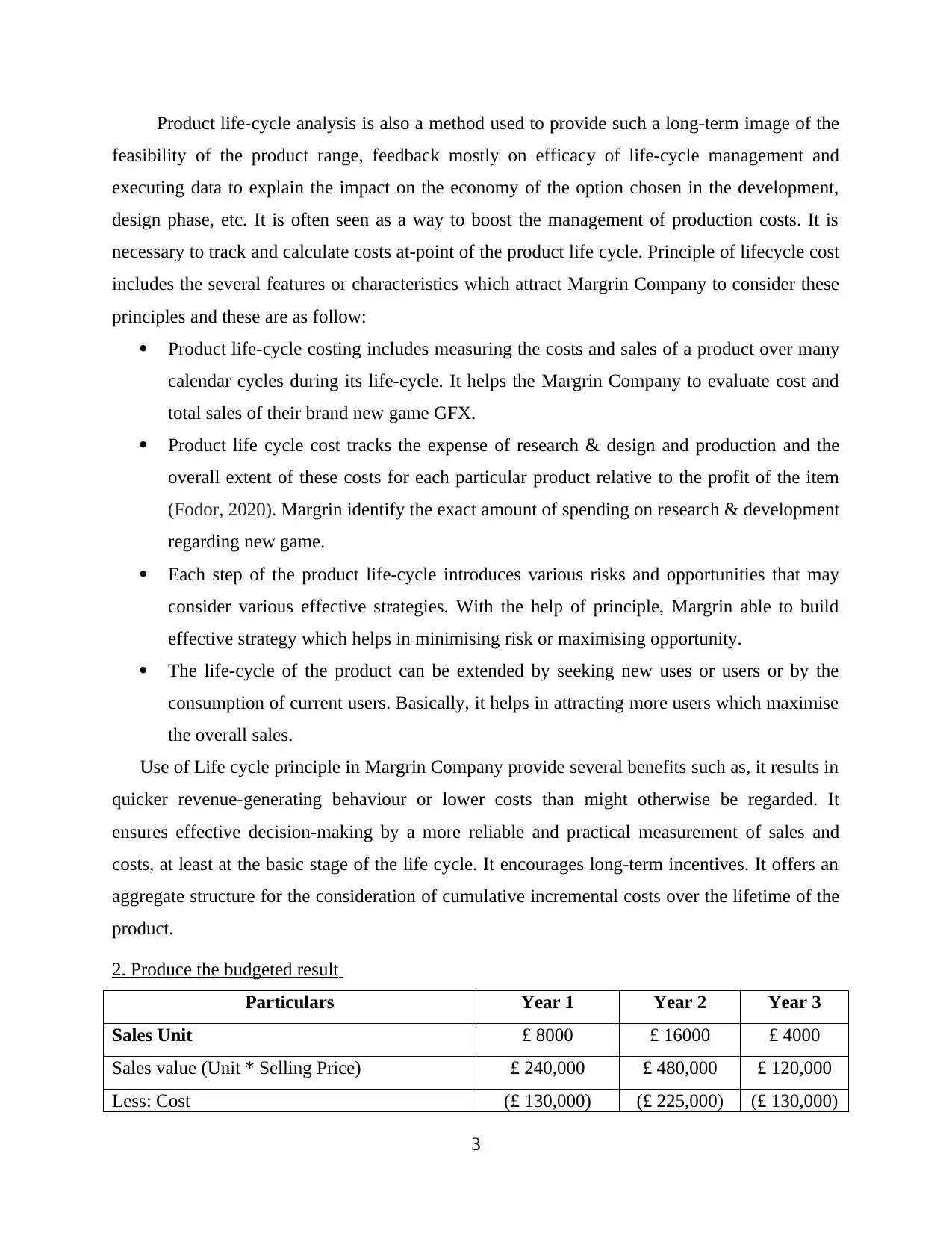
Product life-cycle analysis is also a method used to provide such a long-term image of the
feasibility of the product range, feedback mostly on efficacy of life-cycle management and
executing data to explain the impact on the economy of the option chosen in the development,
design phase, etc. It is often seen as a way to boost the management of production costs. It is
necessary to track and calculate costs at-point of the product life cycle. Principle of lifecycle cost
includes the several features or characteristics which attract Margrin Company to consider these
principles and these are as follow:
Product life-cycle costing includes measuring the costs and sales of a product over many
calendar cycles during its life-cycle. It helps the Margrin Company to evaluate cost and
total sales of their brand new game GFX.
Product life cycle cost tracks the expense of research & design and production and the
overall extent of these costs for each particular product relative to the profit of the item
(Fodor, 2020). Margrin identify the exact amount of spending on research & development
regarding new game.
Each step of the product life-cycle introduces various risks and opportunities that may
consider various effective strategies. With the help of principle, Margrin able to build
effective strategy which helps in minimising risk or maximising opportunity.
The life-cycle of the product can be extended by seeking new uses or users or by the
consumption of current users. Basically, it helps in attracting more users which maximise
the overall sales.
Use of Life cycle principle in Margrin Company provide several benefits such as, it results in
quicker revenue-generating behaviour or lower costs than might otherwise be regarded. It
ensures effective decision-making by a more reliable and practical measurement of sales and
costs, at least at the basic stage of the life cycle. It encourages long-term incentives. It offers an
aggregate structure for the consideration of cumulative incremental costs over the lifetime of the
product.
2. Produce the budgeted result
Particulars Year 1 Year 2 Year 3
Sales Unit £ 8000 £ 16000 £ 4000
Sales value (Unit * Selling Price) £ 240,000 £ 480,000 £ 120,000
Less: Cost (£ 130,000) (£ 225,000) (£ 130,000)
3
feasibility of the product range, feedback mostly on efficacy of life-cycle management and
executing data to explain the impact on the economy of the option chosen in the development,
design phase, etc. It is often seen as a way to boost the management of production costs. It is
necessary to track and calculate costs at-point of the product life cycle. Principle of lifecycle cost
includes the several features or characteristics which attract Margrin Company to consider these
principles and these are as follow:
Product life-cycle costing includes measuring the costs and sales of a product over many
calendar cycles during its life-cycle. It helps the Margrin Company to evaluate cost and
total sales of their brand new game GFX.
Product life cycle cost tracks the expense of research & design and production and the
overall extent of these costs for each particular product relative to the profit of the item
(Fodor, 2020). Margrin identify the exact amount of spending on research & development
regarding new game.
Each step of the product life-cycle introduces various risks and opportunities that may
consider various effective strategies. With the help of principle, Margrin able to build
effective strategy which helps in minimising risk or maximising opportunity.
The life-cycle of the product can be extended by seeking new uses or users or by the
consumption of current users. Basically, it helps in attracting more users which maximise
the overall sales.
Use of Life cycle principle in Margrin Company provide several benefits such as, it results in
quicker revenue-generating behaviour or lower costs than might otherwise be regarded. It
ensures effective decision-making by a more reliable and practical measurement of sales and
costs, at least at the basic stage of the life cycle. It encourages long-term incentives. It offers an
aggregate structure for the consideration of cumulative incremental costs over the lifetime of the
product.
2. Produce the budgeted result
Particulars Year 1 Year 2 Year 3
Sales Unit £ 8000 £ 16000 £ 4000
Sales value (Unit * Selling Price) £ 240,000 £ 480,000 £ 120,000
Less: Cost (£ 130,000) (£ 225,000) (£ 130,000)
3
Paraphrase This Document
Need a fresh take? Get an instant paraphrase of this document with our AI Paraphraser
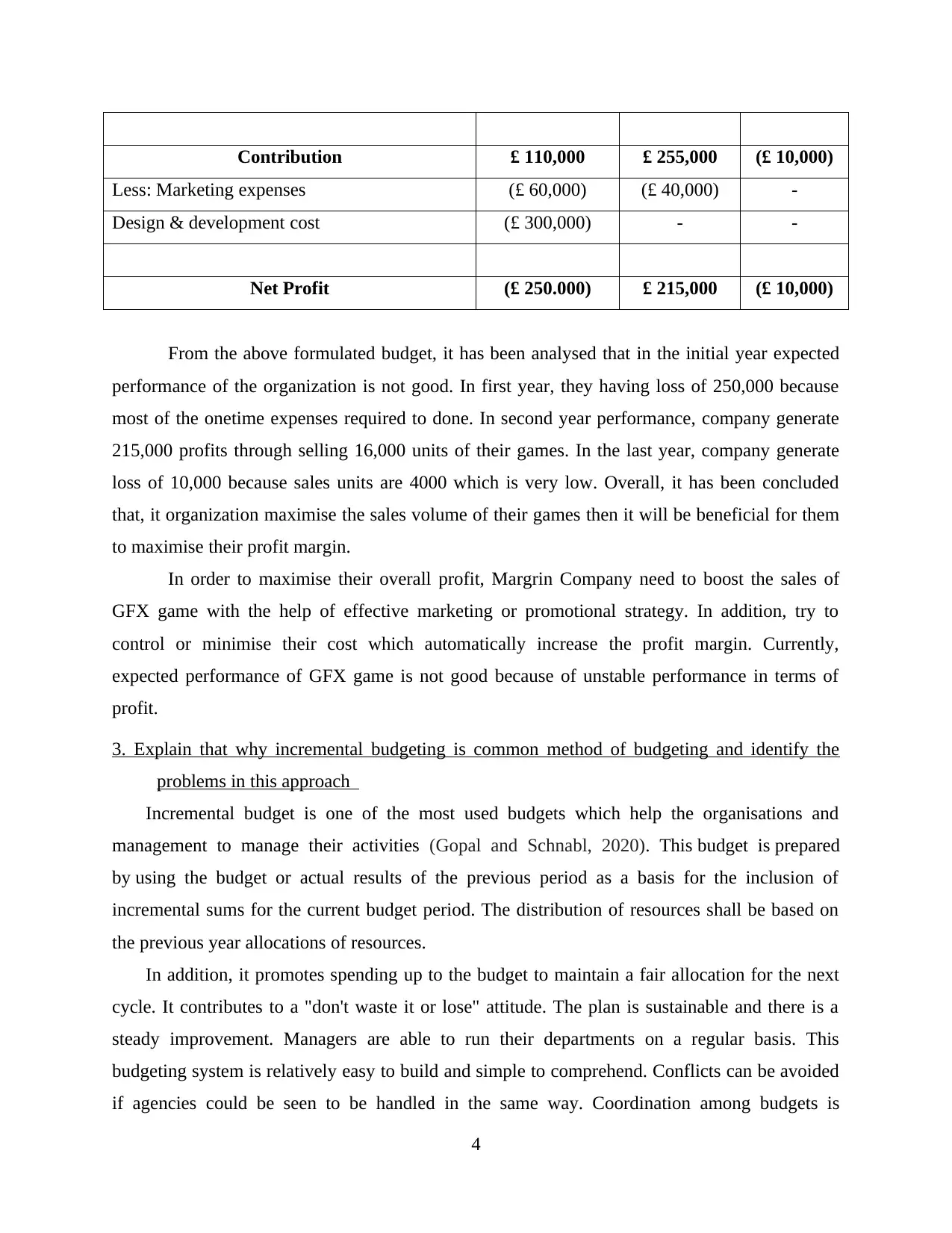
Contribution £ 110,000 £ 255,000 (£ 10,000)
Less: Marketing expenses (£ 60,000) (£ 40,000) -
Design & development cost (£ 300,000) - -
Net Profit (£ 250.000) £ 215,000 (£ 10,000)
From the above formulated budget, it has been analysed that in the initial year expected
performance of the organization is not good. In first year, they having loss of 250,000 because
most of the onetime expenses required to done. In second year performance, company generate
215,000 profits through selling 16,000 units of their games. In the last year, company generate
loss of 10,000 because sales units are 4000 which is very low. Overall, it has been concluded
that, it organization maximise the sales volume of their games then it will be beneficial for them
to maximise their profit margin.
In order to maximise their overall profit, Margrin Company need to boost the sales of
GFX game with the help of effective marketing or promotional strategy. In addition, try to
control or minimise their cost which automatically increase the profit margin. Currently,
expected performance of GFX game is not good because of unstable performance in terms of
profit.
3. Explain that why incremental budgeting is common method of budgeting and identify the
problems in this approach
Incremental budget is one of the most used budgets which help the organisations and
management to manage their activities (Gopal and Schnabl, 2020). This budget is prepared
by using the budget or actual results of the previous period as a basis for the inclusion of
incremental sums for the current budget period. The distribution of resources shall be based on
the previous year allocations of resources.
In addition, it promotes spending up to the budget to maintain a fair allocation for the next
cycle. It contributes to a "don't waste it or lose" attitude. The plan is sustainable and there is a
steady improvement. Managers are able to run their departments on a regular basis. This
budgeting system is relatively easy to build and simple to comprehend. Conflicts can be avoided
if agencies could be seen to be handled in the same way. Coordination among budgets is
4
Less: Marketing expenses (£ 60,000) (£ 40,000) -
Design & development cost (£ 300,000) - -
Net Profit (£ 250.000) £ 215,000 (£ 10,000)
From the above formulated budget, it has been analysed that in the initial year expected
performance of the organization is not good. In first year, they having loss of 250,000 because
most of the onetime expenses required to done. In second year performance, company generate
215,000 profits through selling 16,000 units of their games. In the last year, company generate
loss of 10,000 because sales units are 4000 which is very low. Overall, it has been concluded
that, it organization maximise the sales volume of their games then it will be beneficial for them
to maximise their profit margin.
In order to maximise their overall profit, Margrin Company need to boost the sales of
GFX game with the help of effective marketing or promotional strategy. In addition, try to
control or minimise their cost which automatically increase the profit margin. Currently,
expected performance of GFX game is not good because of unstable performance in terms of
profit.
3. Explain that why incremental budgeting is common method of budgeting and identify the
problems in this approach
Incremental budget is one of the most used budgets which help the organisations and
management to manage their activities (Gopal and Schnabl, 2020). This budget is prepared
by using the budget or actual results of the previous period as a basis for the inclusion of
incremental sums for the current budget period. The distribution of resources shall be based on
the previous year allocations of resources.
In addition, it promotes spending up to the budget to maintain a fair allocation for the next
cycle. It contributes to a "don't waste it or lose" attitude. The plan is sustainable and there is a
steady improvement. Managers are able to run their departments on a regular basis. This
budgeting system is relatively easy to build and simple to comprehend. Conflicts can be avoided
if agencies could be seen to be handled in the same way. Coordination among budgets is
4
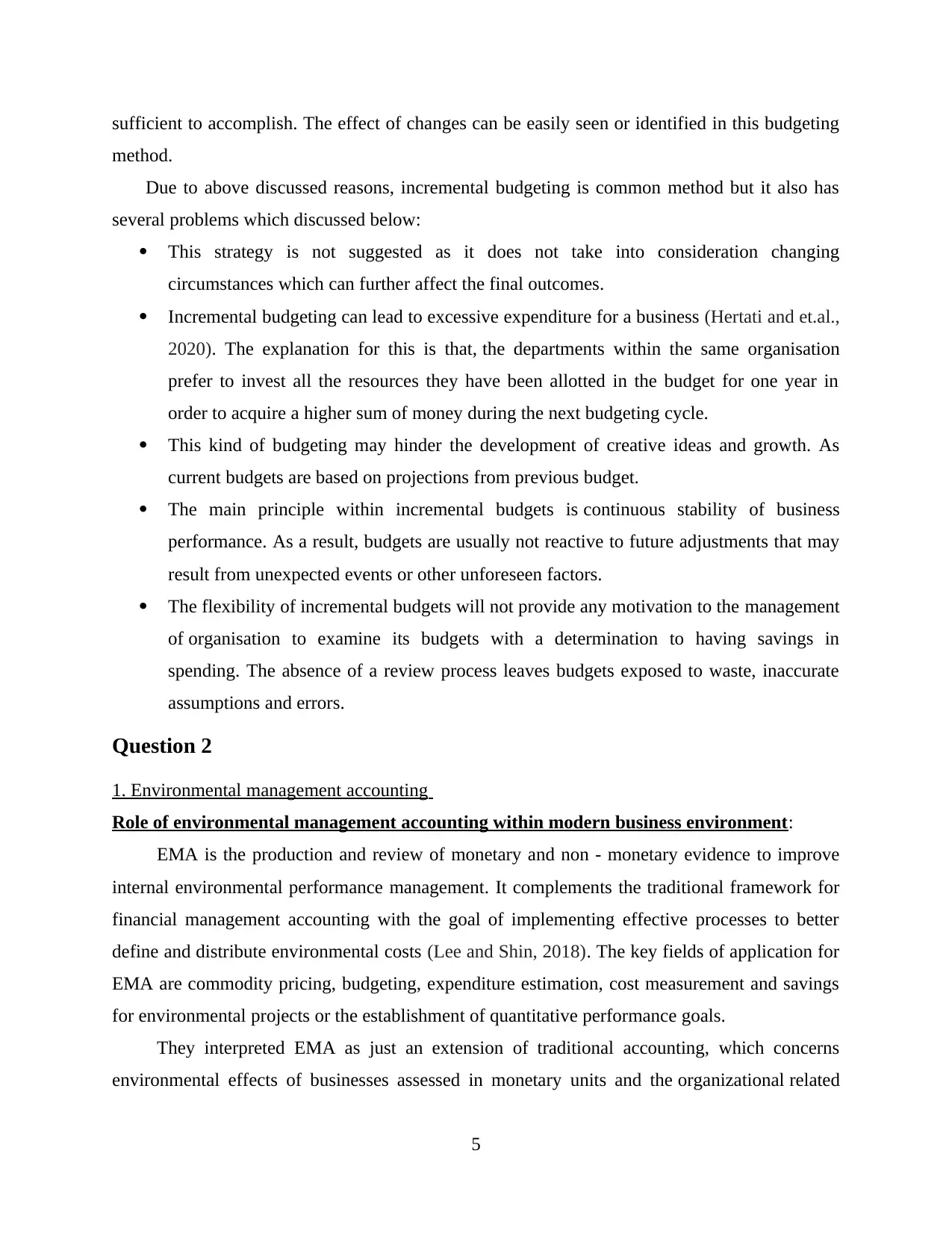
sufficient to accomplish. The effect of changes can be easily seen or identified in this budgeting
method.
Due to above discussed reasons, incremental budgeting is common method but it also has
several problems which discussed below:
This strategy is not suggested as it does not take into consideration changing
circumstances which can further affect the final outcomes.
Incremental budgeting can lead to excessive expenditure for a business (Hertati and et.al.,
2020). The explanation for this is that, the departments within the same organisation
prefer to invest all the resources they have been allotted in the budget for one year in
order to acquire a higher sum of money during the next budgeting cycle.
This kind of budgeting may hinder the development of creative ideas and growth. As
current budgets are based on projections from previous budget.
The main principle within incremental budgets is continuous stability of business
performance. As a result, budgets are usually not reactive to future adjustments that may
result from unexpected events or other unforeseen factors.
The flexibility of incremental budgets will not provide any motivation to the management
of organisation to examine its budgets with a determination to having savings in
spending. The absence of a review process leaves budgets exposed to waste, inaccurate
assumptions and errors.
Question 2
1. Environmental management accounting
Role of environmental management accounting within modern business environment:
EMA is the production and review of monetary and non - monetary evidence to improve
internal environmental performance management. It complements the traditional framework for
financial management accounting with the goal of implementing effective processes to better
define and distribute environmental costs (Lee and Shin, 2018). The key fields of application for
EMA are commodity pricing, budgeting, expenditure estimation, cost measurement and savings
for environmental projects or the establishment of quantitative performance goals.
They interpreted EMA as just an extension of traditional accounting, which concerns
environmental effects of businesses assessed in monetary units and the organizational related
5
method.
Due to above discussed reasons, incremental budgeting is common method but it also has
several problems which discussed below:
This strategy is not suggested as it does not take into consideration changing
circumstances which can further affect the final outcomes.
Incremental budgeting can lead to excessive expenditure for a business (Hertati and et.al.,
2020). The explanation for this is that, the departments within the same organisation
prefer to invest all the resources they have been allotted in the budget for one year in
order to acquire a higher sum of money during the next budgeting cycle.
This kind of budgeting may hinder the development of creative ideas and growth. As
current budgets are based on projections from previous budget.
The main principle within incremental budgets is continuous stability of business
performance. As a result, budgets are usually not reactive to future adjustments that may
result from unexpected events or other unforeseen factors.
The flexibility of incremental budgets will not provide any motivation to the management
of organisation to examine its budgets with a determination to having savings in
spending. The absence of a review process leaves budgets exposed to waste, inaccurate
assumptions and errors.
Question 2
1. Environmental management accounting
Role of environmental management accounting within modern business environment:
EMA is the production and review of monetary and non - monetary evidence to improve
internal environmental performance management. It complements the traditional framework for
financial management accounting with the goal of implementing effective processes to better
define and distribute environmental costs (Lee and Shin, 2018). The key fields of application for
EMA are commodity pricing, budgeting, expenditure estimation, cost measurement and savings
for environmental projects or the establishment of quantitative performance goals.
They interpreted EMA as just an extension of traditional accounting, which concerns
environmental effects of businesses assessed in monetary units and the organizational related
5
⊘ This is a preview!⊘
Do you want full access?
Subscribe today to unlock all pages.

Trusted by 1+ million students worldwide
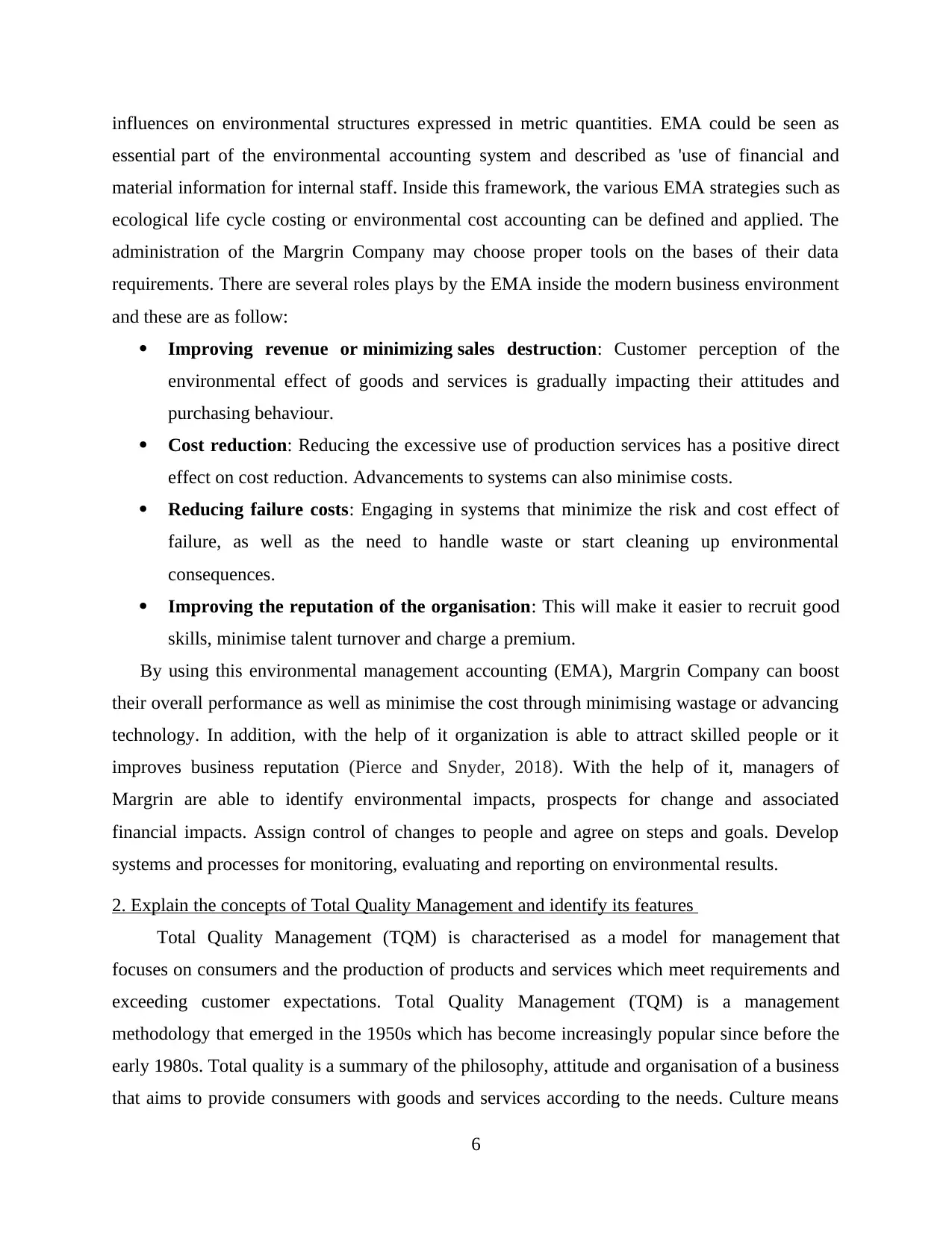
influences on environmental structures expressed in metric quantities. EMA could be seen as
essential part of the environmental accounting system and described as 'use of financial and
material information for internal staff. Inside this framework, the various EMA strategies such as
ecological life cycle costing or environmental cost accounting can be defined and applied. The
administration of the Margrin Company may choose proper tools on the bases of their data
requirements. There are several roles plays by the EMA inside the modern business environment
and these are as follow:
Improving revenue or minimizing sales destruction: Customer perception of the
environmental effect of goods and services is gradually impacting their attitudes and
purchasing behaviour.
Cost reduction: Reducing the excessive use of production services has a positive direct
effect on cost reduction. Advancements to systems can also minimise costs.
Reducing failure costs: Engaging in systems that minimize the risk and cost effect of
failure, as well as the need to handle waste or start cleaning up environmental
consequences.
Improving the reputation of the organisation: This will make it easier to recruit good
skills, minimise talent turnover and charge a premium.
By using this environmental management accounting (EMA), Margrin Company can boost
their overall performance as well as minimise the cost through minimising wastage or advancing
technology. In addition, with the help of it organization is able to attract skilled people or it
improves business reputation (Pierce and Snyder, 2018). With the help of it, managers of
Margrin are able to identify environmental impacts, prospects for change and associated
financial impacts. Assign control of changes to people and agree on steps and goals. Develop
systems and processes for monitoring, evaluating and reporting on environmental results.
2. Explain the concepts of Total Quality Management and identify its features
Total Quality Management (TQM) is characterised as a model for management that
focuses on consumers and the production of products and services which meet requirements and
exceeding customer expectations. Total Quality Management (TQM) is a management
methodology that emerged in the 1950s which has become increasingly popular since before the
early 1980s. Total quality is a summary of the philosophy, attitude and organisation of a business
that aims to provide consumers with goods and services according to the needs. Culture means
6
essential part of the environmental accounting system and described as 'use of financial and
material information for internal staff. Inside this framework, the various EMA strategies such as
ecological life cycle costing or environmental cost accounting can be defined and applied. The
administration of the Margrin Company may choose proper tools on the bases of their data
requirements. There are several roles plays by the EMA inside the modern business environment
and these are as follow:
Improving revenue or minimizing sales destruction: Customer perception of the
environmental effect of goods and services is gradually impacting their attitudes and
purchasing behaviour.
Cost reduction: Reducing the excessive use of production services has a positive direct
effect on cost reduction. Advancements to systems can also minimise costs.
Reducing failure costs: Engaging in systems that minimize the risk and cost effect of
failure, as well as the need to handle waste or start cleaning up environmental
consequences.
Improving the reputation of the organisation: This will make it easier to recruit good
skills, minimise talent turnover and charge a premium.
By using this environmental management accounting (EMA), Margrin Company can boost
their overall performance as well as minimise the cost through minimising wastage or advancing
technology. In addition, with the help of it organization is able to attract skilled people or it
improves business reputation (Pierce and Snyder, 2018). With the help of it, managers of
Margrin are able to identify environmental impacts, prospects for change and associated
financial impacts. Assign control of changes to people and agree on steps and goals. Develop
systems and processes for monitoring, evaluating and reporting on environmental results.
2. Explain the concepts of Total Quality Management and identify its features
Total Quality Management (TQM) is characterised as a model for management that
focuses on consumers and the production of products and services which meet requirements and
exceeding customer expectations. Total Quality Management (TQM) is a management
methodology that emerged in the 1950s which has become increasingly popular since before the
early 1980s. Total quality is a summary of the philosophy, attitude and organisation of a business
that aims to provide consumers with goods and services according to the needs. Culture means
6
Paraphrase This Document
Need a fresh take? Get an instant paraphrase of this document with our AI Paraphraser
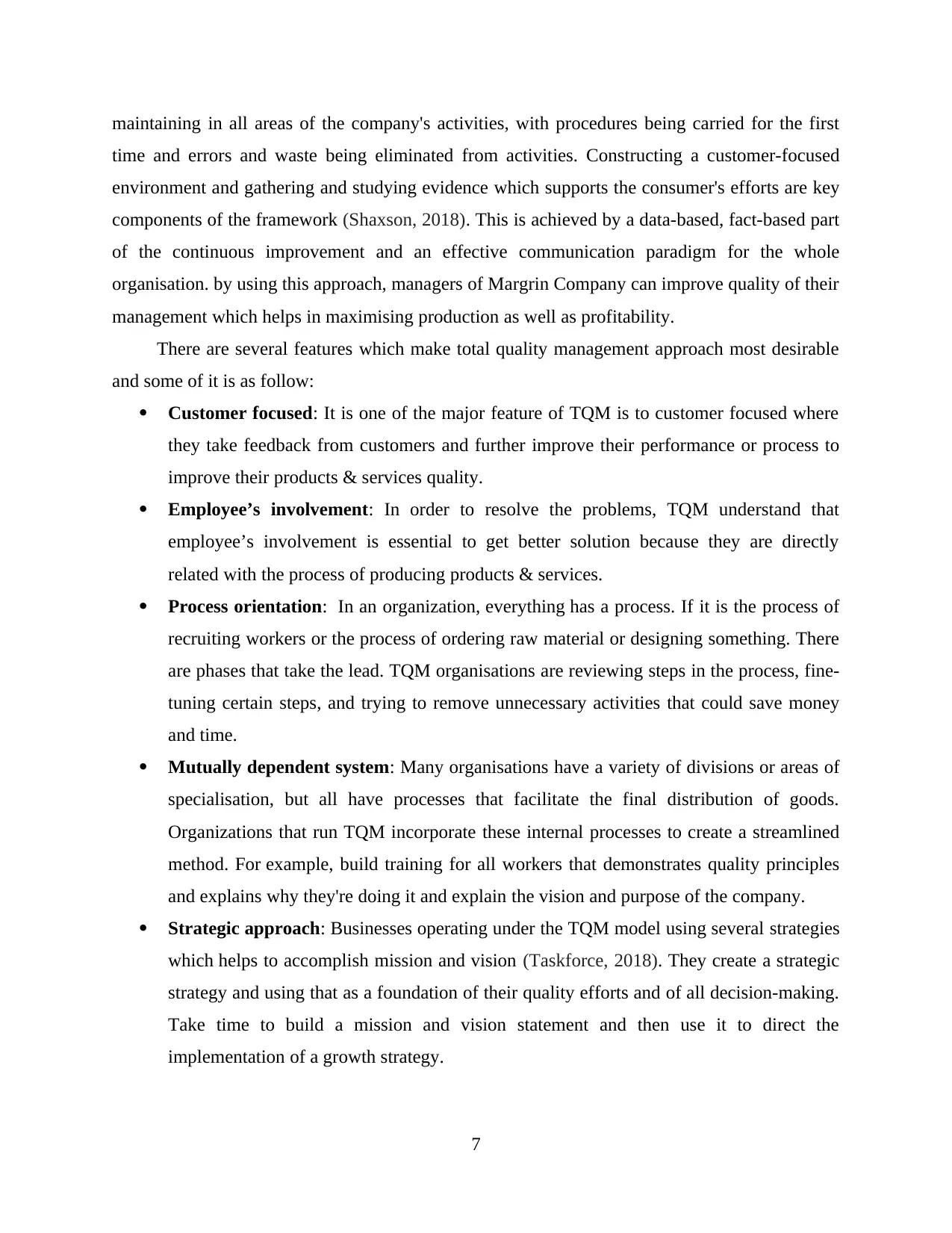
maintaining in all areas of the company's activities, with procedures being carried for the first
time and errors and waste being eliminated from activities. Constructing a customer-focused
environment and gathering and studying evidence which supports the consumer's efforts are key
components of the framework (Shaxson, 2018). This is achieved by a data-based, fact-based part
of the continuous improvement and an effective communication paradigm for the whole
organisation. by using this approach, managers of Margrin Company can improve quality of their
management which helps in maximising production as well as profitability.
There are several features which make total quality management approach most desirable
and some of it is as follow:
Customer focused: It is one of the major feature of TQM is to customer focused where
they take feedback from customers and further improve their performance or process to
improve their products & services quality.
Employee’s involvement: In order to resolve the problems, TQM understand that
employee’s involvement is essential to get better solution because they are directly
related with the process of producing products & services.
Process orientation: In an organization, everything has a process. If it is the process of
recruiting workers or the process of ordering raw material or designing something. There
are phases that take the lead. TQM organisations are reviewing steps in the process, fine-
tuning certain steps, and trying to remove unnecessary activities that could save money
and time.
Mutually dependent system: Many organisations have a variety of divisions or areas of
specialisation, but all have processes that facilitate the final distribution of goods.
Organizations that run TQM incorporate these internal processes to create a streamlined
method. For example, build training for all workers that demonstrates quality principles
and explains why they're doing it and explain the vision and purpose of the company.
Strategic approach: Businesses operating under the TQM model using several strategies
which helps to accomplish mission and vision (Taskforce, 2018). They create a strategic
strategy and using that as a foundation of their quality efforts and of all decision-making.
Take time to build a mission and vision statement and then use it to direct the
implementation of a growth strategy.
7
time and errors and waste being eliminated from activities. Constructing a customer-focused
environment and gathering and studying evidence which supports the consumer's efforts are key
components of the framework (Shaxson, 2018). This is achieved by a data-based, fact-based part
of the continuous improvement and an effective communication paradigm for the whole
organisation. by using this approach, managers of Margrin Company can improve quality of their
management which helps in maximising production as well as profitability.
There are several features which make total quality management approach most desirable
and some of it is as follow:
Customer focused: It is one of the major feature of TQM is to customer focused where
they take feedback from customers and further improve their performance or process to
improve their products & services quality.
Employee’s involvement: In order to resolve the problems, TQM understand that
employee’s involvement is essential to get better solution because they are directly
related with the process of producing products & services.
Process orientation: In an organization, everything has a process. If it is the process of
recruiting workers or the process of ordering raw material or designing something. There
are phases that take the lead. TQM organisations are reviewing steps in the process, fine-
tuning certain steps, and trying to remove unnecessary activities that could save money
and time.
Mutually dependent system: Many organisations have a variety of divisions or areas of
specialisation, but all have processes that facilitate the final distribution of goods.
Organizations that run TQM incorporate these internal processes to create a streamlined
method. For example, build training for all workers that demonstrates quality principles
and explains why they're doing it and explain the vision and purpose of the company.
Strategic approach: Businesses operating under the TQM model using several strategies
which helps to accomplish mission and vision (Taskforce, 2018). They create a strategic
strategy and using that as a foundation of their quality efforts and of all decision-making.
Take time to build a mission and vision statement and then use it to direct the
implementation of a growth strategy.
7
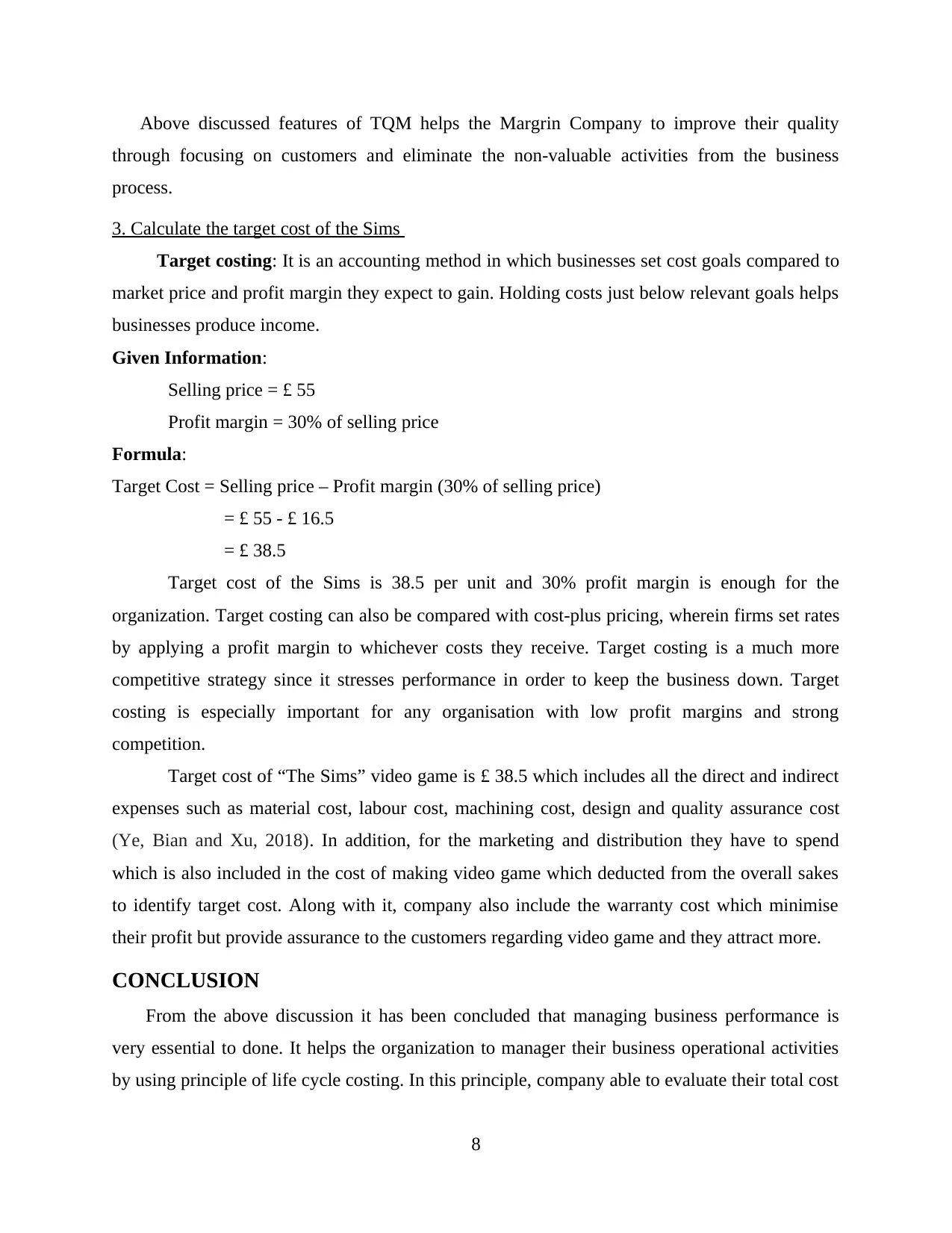
Above discussed features of TQM helps the Margrin Company to improve their quality
through focusing on customers and eliminate the non-valuable activities from the business
process.
3. Calculate the target cost of the Sims
Target costing: It is an accounting method in which businesses set cost goals compared to
market price and profit margin they expect to gain. Holding costs just below relevant goals helps
businesses produce income.
Given Information:
Selling price = £ 55
Profit margin = 30% of selling price
Formula:
Target Cost = Selling price – Profit margin (30% of selling price)
= £ 55 - £ 16.5
= £ 38.5
Target cost of the Sims is 38.5 per unit and 30% profit margin is enough for the
organization. Target costing can also be compared with cost-plus pricing, wherein firms set rates
by applying a profit margin to whichever costs they receive. Target costing is a much more
competitive strategy since it stresses performance in order to keep the business down. Target
costing is especially important for any organisation with low profit margins and strong
competition.
Target cost of “The Sims” video game is £ 38.5 which includes all the direct and indirect
expenses such as material cost, labour cost, machining cost, design and quality assurance cost
(Ye, Bian and Xu, 2018). In addition, for the marketing and distribution they have to spend
which is also included in the cost of making video game which deducted from the overall sakes
to identify target cost. Along with it, company also include the warranty cost which minimise
their profit but provide assurance to the customers regarding video game and they attract more.
CONCLUSION
From the above discussion it has been concluded that managing business performance is
very essential to done. It helps the organization to manager their business operational activities
by using principle of life cycle costing. In this principle, company able to evaluate their total cost
8
through focusing on customers and eliminate the non-valuable activities from the business
process.
3. Calculate the target cost of the Sims
Target costing: It is an accounting method in which businesses set cost goals compared to
market price and profit margin they expect to gain. Holding costs just below relevant goals helps
businesses produce income.
Given Information:
Selling price = £ 55
Profit margin = 30% of selling price
Formula:
Target Cost = Selling price – Profit margin (30% of selling price)
= £ 55 - £ 16.5
= £ 38.5
Target cost of the Sims is 38.5 per unit and 30% profit margin is enough for the
organization. Target costing can also be compared with cost-plus pricing, wherein firms set rates
by applying a profit margin to whichever costs they receive. Target costing is a much more
competitive strategy since it stresses performance in order to keep the business down. Target
costing is especially important for any organisation with low profit margins and strong
competition.
Target cost of “The Sims” video game is £ 38.5 which includes all the direct and indirect
expenses such as material cost, labour cost, machining cost, design and quality assurance cost
(Ye, Bian and Xu, 2018). In addition, for the marketing and distribution they have to spend
which is also included in the cost of making video game which deducted from the overall sakes
to identify target cost. Along with it, company also include the warranty cost which minimise
their profit but provide assurance to the customers regarding video game and they attract more.
CONCLUSION
From the above discussion it has been concluded that managing business performance is
very essential to done. It helps the organization to manager their business operational activities
by using principle of life cycle costing. In this principle, company able to evaluate their total cost
8
⊘ This is a preview!⊘
Do you want full access?
Subscribe today to unlock all pages.

Trusted by 1+ million students worldwide
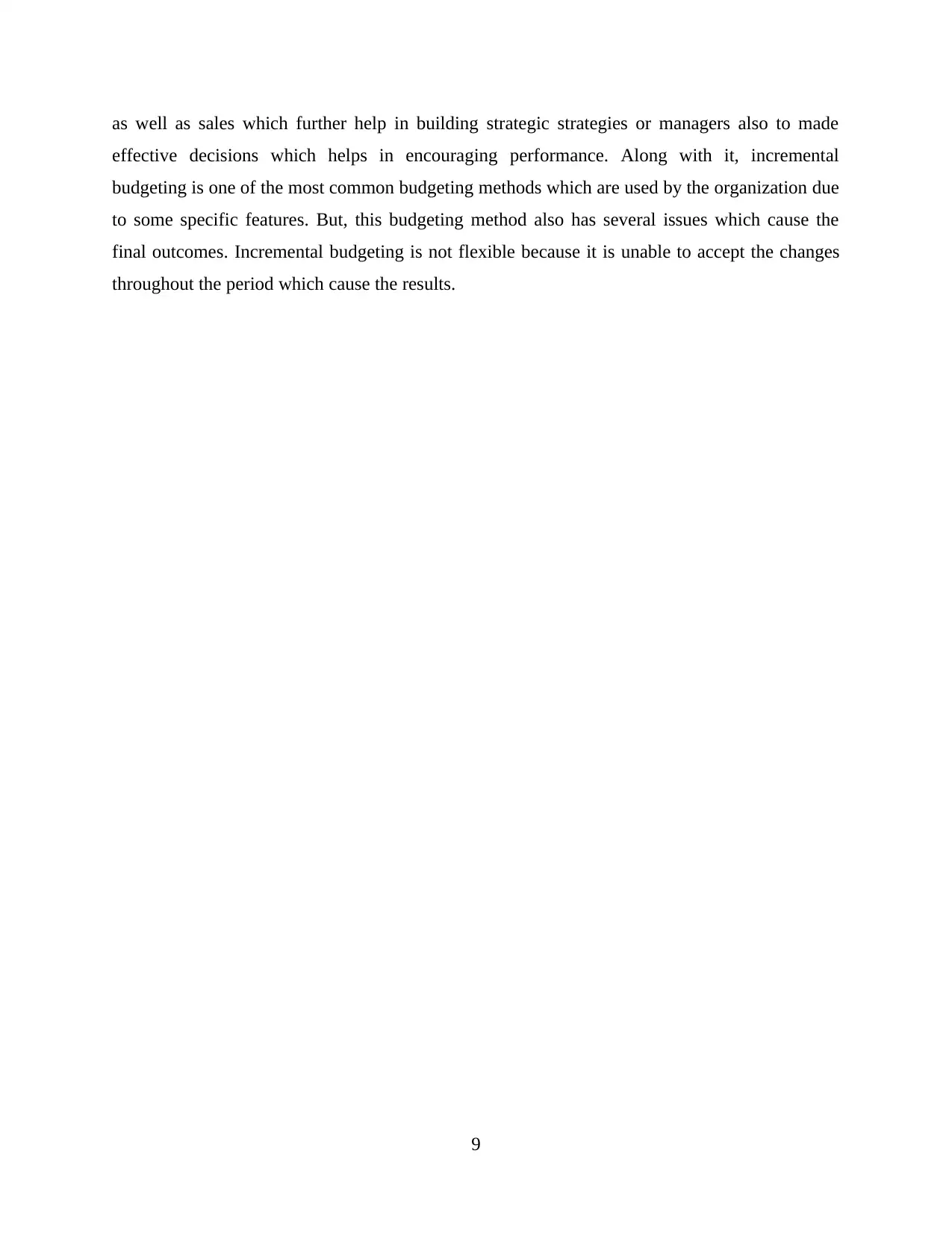
as well as sales which further help in building strategic strategies or managers also to made
effective decisions which helps in encouraging performance. Along with it, incremental
budgeting is one of the most common budgeting methods which are used by the organization due
to some specific features. But, this budgeting method also has several issues which cause the
final outcomes. Incremental budgeting is not flexible because it is unable to accept the changes
throughout the period which cause the results.
9
effective decisions which helps in encouraging performance. Along with it, incremental
budgeting is one of the most common budgeting methods which are used by the organization due
to some specific features. But, this budgeting method also has several issues which cause the
final outcomes. Incremental budgeting is not flexible because it is unable to accept the changes
throughout the period which cause the results.
9
Paraphrase This Document
Need a fresh take? Get an instant paraphrase of this document with our AI Paraphraser
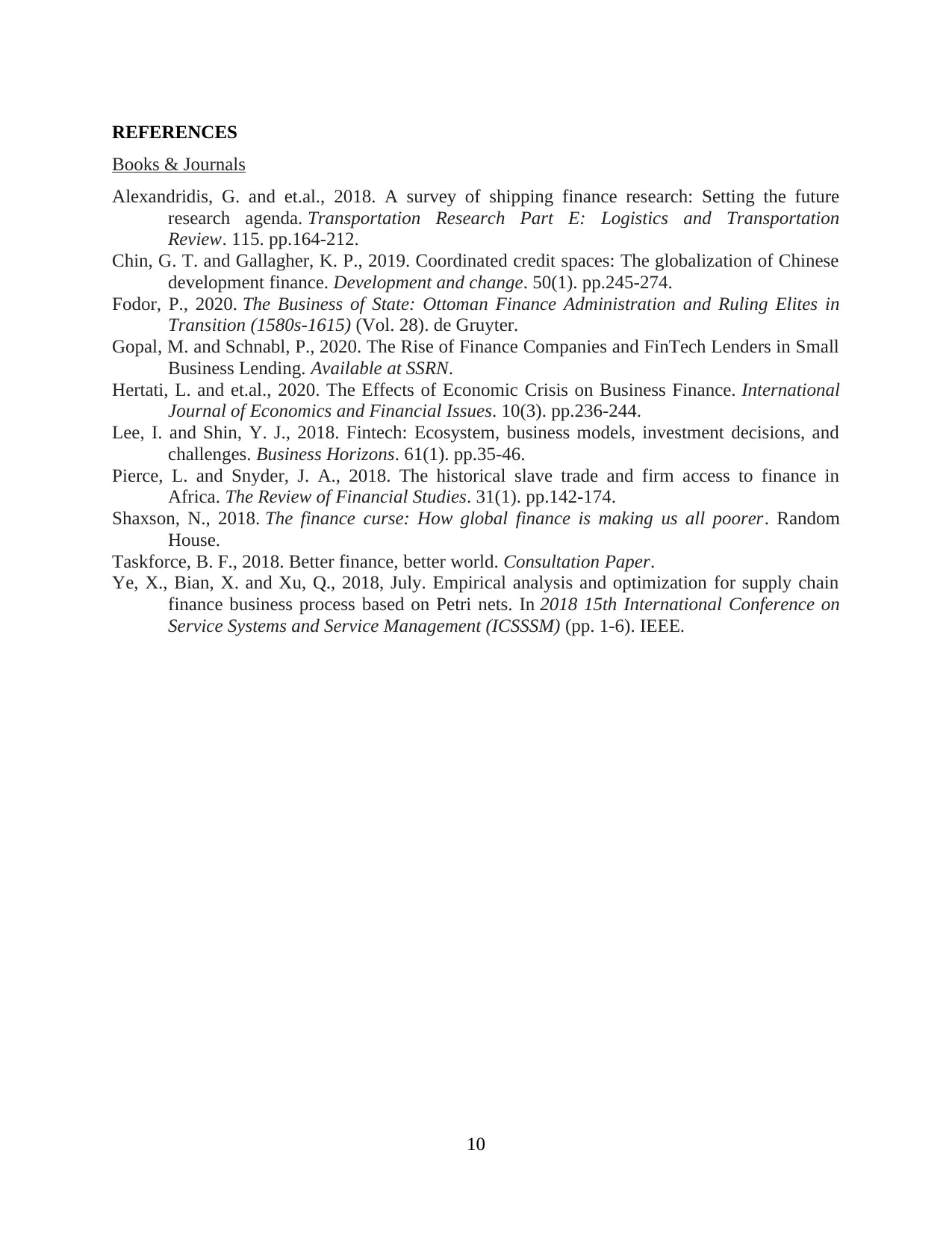
REFERENCES
Books & Journals
Alexandridis, G. and et.al., 2018. A survey of shipping finance research: Setting the future
research agenda. Transportation Research Part E: Logistics and Transportation
Review. 115. pp.164-212.
Chin, G. T. and Gallagher, K. P., 2019. Coordinated credit spaces: The globalization of Chinese
development finance. Development and change. 50(1). pp.245-274.
Fodor, P., 2020. The Business of State: Ottoman Finance Administration and Ruling Elites in
Transition (1580s-1615) (Vol. 28). de Gruyter.
Gopal, M. and Schnabl, P., 2020. The Rise of Finance Companies and FinTech Lenders in Small
Business Lending. Available at SSRN.
Hertati, L. and et.al., 2020. The Effects of Economic Crisis on Business Finance. International
Journal of Economics and Financial Issues. 10(3). pp.236-244.
Lee, I. and Shin, Y. J., 2018. Fintech: Ecosystem, business models, investment decisions, and
challenges. Business Horizons. 61(1). pp.35-46.
Pierce, L. and Snyder, J. A., 2018. The historical slave trade and firm access to finance in
Africa. The Review of Financial Studies. 31(1). pp.142-174.
Shaxson, N., 2018. The finance curse: How global finance is making us all poorer. Random
House.
Taskforce, B. F., 2018. Better finance, better world. Consultation Paper.
Ye, X., Bian, X. and Xu, Q., 2018, July. Empirical analysis and optimization for supply chain
finance business process based on Petri nets. In 2018 15th International Conference on
Service Systems and Service Management (ICSSSM) (pp. 1-6). IEEE.
10
Books & Journals
Alexandridis, G. and et.al., 2018. A survey of shipping finance research: Setting the future
research agenda. Transportation Research Part E: Logistics and Transportation
Review. 115. pp.164-212.
Chin, G. T. and Gallagher, K. P., 2019. Coordinated credit spaces: The globalization of Chinese
development finance. Development and change. 50(1). pp.245-274.
Fodor, P., 2020. The Business of State: Ottoman Finance Administration and Ruling Elites in
Transition (1580s-1615) (Vol. 28). de Gruyter.
Gopal, M. and Schnabl, P., 2020. The Rise of Finance Companies and FinTech Lenders in Small
Business Lending. Available at SSRN.
Hertati, L. and et.al., 2020. The Effects of Economic Crisis on Business Finance. International
Journal of Economics and Financial Issues. 10(3). pp.236-244.
Lee, I. and Shin, Y. J., 2018. Fintech: Ecosystem, business models, investment decisions, and
challenges. Business Horizons. 61(1). pp.35-46.
Pierce, L. and Snyder, J. A., 2018. The historical slave trade and firm access to finance in
Africa. The Review of Financial Studies. 31(1). pp.142-174.
Shaxson, N., 2018. The finance curse: How global finance is making us all poorer. Random
House.
Taskforce, B. F., 2018. Better finance, better world. Consultation Paper.
Ye, X., Bian, X. and Xu, Q., 2018, July. Empirical analysis and optimization for supply chain
finance business process based on Petri nets. In 2018 15th International Conference on
Service Systems and Service Management (ICSSSM) (pp. 1-6). IEEE.
10
1 out of 11
Related Documents
Your All-in-One AI-Powered Toolkit for Academic Success.
+13062052269
info@desklib.com
Available 24*7 on WhatsApp / Email
![[object Object]](/_next/static/media/star-bottom.7253800d.svg)
Unlock your academic potential
Copyright © 2020–2025 A2Z Services. All Rights Reserved. Developed and managed by ZUCOL.





